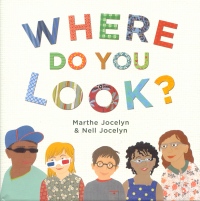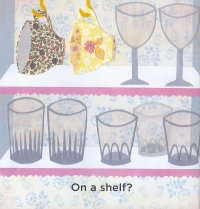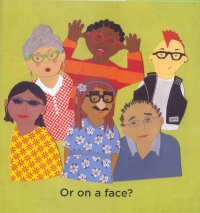| ________________
CM . . .
. Volume XIX Number 32. . . .April 19, 2013
excerpt:
Where Do You Look? is written by the mother and daughter team of Marthe and Nell The book is marketed as a “playful exploration of homonyms.” They explore the multiple meanings of words, such as button, glasses, tongue, match and trunk. The reader then hunts for the illustration of the word in two or more contexts to develop understanding of vocabulary and multiple meanings of the word. The study of vocabulary here is of homonyms that are words that sound and look the same but have different meanings not to be confused with homophones, words that sound the same but are spelled differently and have different meanings. The layout of the book and text patterns is inconsistent. At times, the examples are found after turning the page with the question asking where the item could be found. Other times, it is located on the same spread of the page. It is most helpful when the two examples are side by side to illustrate the multiple meanings. Recommended with reservations. Susan Barnabe, a retired teacher and reading clinician, lives in Winnipeg, MB.
To comment
on this title or this review, send mail to cm@umanitoba.ca.
Copyright © the Manitoba Library Association. Reproduction for personal
use is permitted only if this copyright notice is maintained. Any
other reproduction is prohibited without permission.
NEXT REVIEW |
TABLE OF CONTENTS FOR THIS ISSUE
- April 19, 2013.
AUTHORS |
TITLES |
MEDIA REVIEWS |
PROFILES |
BACK ISSUES |
SEARCH |
CMARCHIVE |
HOME |

 Jocelyn. Marthe is the award-winning author of numerous concept and board books. Her daughter has joined her in this production following her studies in photography. The collages are lovely to view. They consist of fabric letters and pictures, and the composition will delight the preschooler and reader alike.
Jocelyn. Marthe is the award-winning author of numerous concept and board books. Her daughter has joined her in this production following her studies in photography. The collages are lovely to view. They consist of fabric letters and pictures, and the composition will delight the preschooler and reader alike. The search for clarity of word meaning and subsequently comprehension of language are both significant for the early language learner, and this text is a springboard for them. However, the text may require some support from the more experienced reader, parent or teacher. The picture clues are embedded in the collage and not immediately recognizable to the young child. Some of the vocabulary terms are challenging for young children, such as match and story; however, discussion with the child would assist in developing further understanding of such vocabulary.
The search for clarity of word meaning and subsequently comprehension of language are both significant for the early language learner, and this text is a springboard for them. However, the text may require some support from the more experienced reader, parent or teacher. The picture clues are embedded in the collage and not immediately recognizable to the young child. Some of the vocabulary terms are challenging for young children, such as match and story; however, discussion with the child would assist in developing further understanding of such vocabulary.